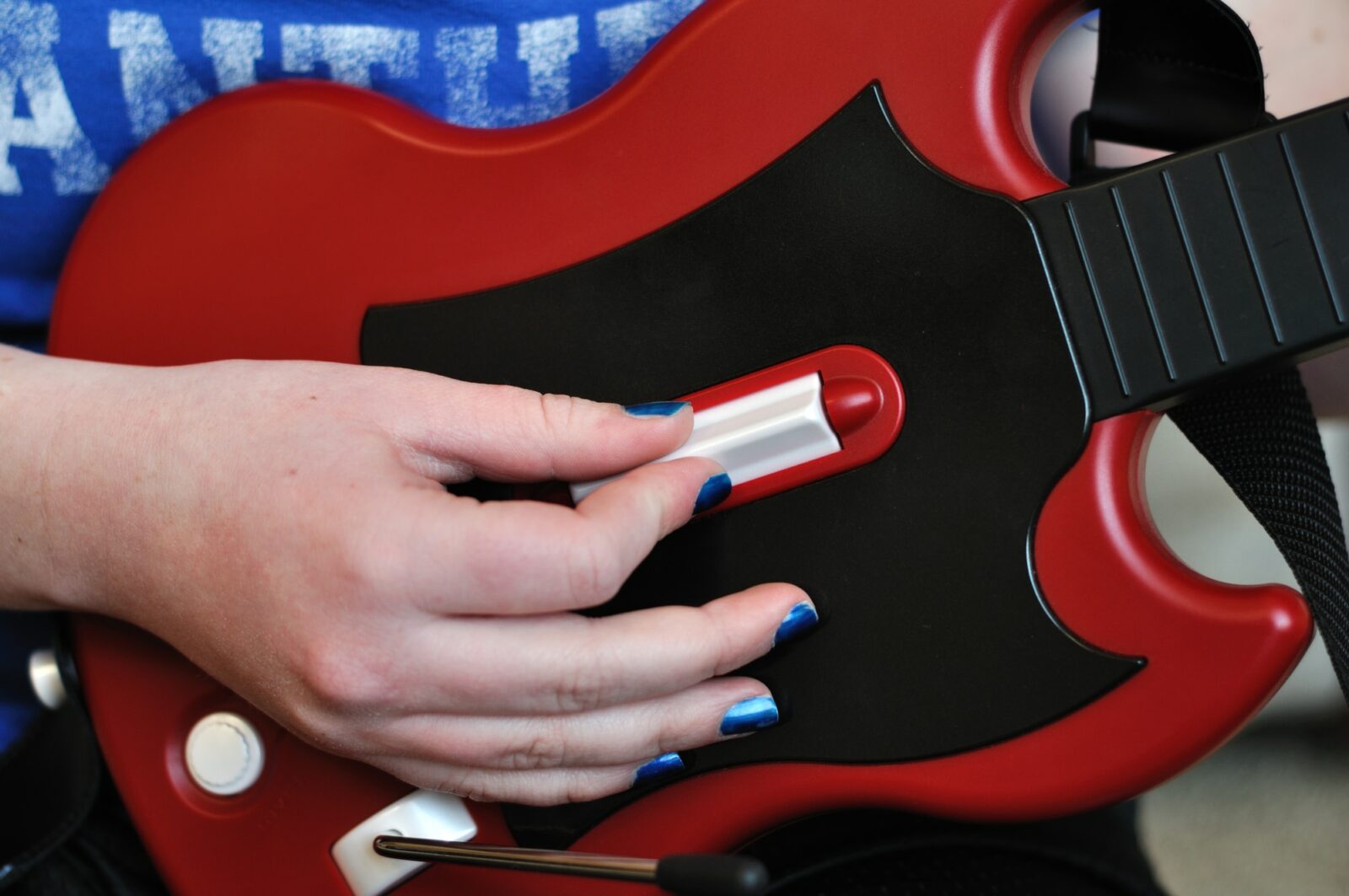There was a time when rock’n’roll also dominated the world of video games and the air guitar had given way to the new Gibson Devil-shaped controllers. Let’s talk about the era of Guitar Hero and rhythm games.
Guitar Hero: the rhythm game to feel like a rock star
Guitar Hero: the whole life experience of a rockstar in your own living room. Without bank accounts, jets and groupies, of course, but with the adrenaline of wielding your tool to get the audience’s ovation. Seen in hindsight, however, it must be said that the entire Guitar Hero franchise was actually a huge wasted opportunity. Perhaps one of the greatest in the history of video games. The first title arrives at the end of 2005, for PlayStation 2, developed by Harmonix Music Systems in collaboration with RedOctane. The result is an unprecedented success: by February 2006 it is the best-selling game for PS2 and within two years it will record 1.53 million copies sold.
What is the reason for all this success? After all i rhythm games they were not a big news: in arcades titles like Beatmania IIDX or Dance Dance Revolution were widespread. But what happened then? Surely the revolution was also aesthetic: with Guitar Hero comes the Gibson SG shaped controller, iconic guitar for all those raised on bread and rock’n’roll, which features five colored frets on the neck, to be pressed in correspondence with the notes highlighted on the screen. Furthermore, it is finally possible to play from home, challenging friends, without the pressure of the other patrons of the arcade. Just this? No: Guitar Hero presents a thrilling musical selection: from Deep Purple to Queen via Jimi Hendrix, Red Hot Chili Peppers and Queens Of The Stone Age. All songs divided by difficulty, giving the player the opportunity to improve and unlock other iconic songs. A game like this had never been seen before, the moral of this story, perhaps, lies entirely in this last statement.
The ways of RedOctane and Harmonix part ways
The toy, however, was about to break, in fact it had already broken, although the fracture was still too small to be visible. In 2006 RodOctane is acquired by Activision. On the other hand, MTV incorporates Harmonix: the two companies that had created the game were now rivals. Activision immediately saw potential in it, and did not miss the opportunity to capitalize, launching in quick succession Rock the 80’s, Guitar Hero III: Legends of Rock and a mobile version: all in 2007. Rock the 80’s was nothing more than a DLC with 80’s songs, but sold for the price of a full game. Guitar Hero III is probably the very pinnacle of the franchise, which reaches very high peaks of gameplay and graphics.
Rock Band: the market is now saturated
In the meantime, however, Harmonix was not watching, and was preparing the launch of its own title that sees the light in 2007: Rock Band. The big news? Not just guitars: with Rock Band it was possible to connect a microphone and sing or even buy pads as drum controllers.
The market was now divided into two very similar franchises in game dynamics, which differ mainly in the soundtrack, depending on the rights acquired by one of the two houses. Both titles sell well, which leads the two companies to push more and more on the accelerator. In 2009 alone Guitar Hero released 7 different titles, a madness that can only be explained in one way: capitalize as much as possible. From the point of view of gameplay, in fact, there is no substantial difference between the various chapters. We are at a point of no return and meanwhile MTV Networks releases, in 2010, Rock Band 3.
Ma the market is now saturated and the costs of the instruments (peripherals, drums, guitar, microphone) and of titles that were almost identical to each other, soon led the bubble to implode. Activision declares in fact, in 2011, the finished brand, although it will launch a final farewell title a few years later.
Guitar Hero Live: the ultimate death
As some bands do with career-ending Reunions, Guitar Hero’s official death comes in 2015, with the release of Guitar Hero Live. A game that shows itself totally renewed from the graphic point of view, with the possibility of playing by watching the video clips of the songs and the live mode in which you perform watching real videos of a band on a stage, with the real audience reacting depending on the quality of the performance. From a gameplay point of view, however, everything remains identical. The only substantial difference concerns the choice of replace the classic 5 colored button system to use one with six keys, divided into two rows of three. Although 4 years have passed since the previous chapter, Guitar Hero Live does not meet Activision’s goals and the Guitar Hero brand leaves the scene definitively.
What was born as an absolute novelty has become, in the space of a few years, a copy of itself. The inability to capitalize in the long term, with new and different titles, has perhaps given the coup de grace to the world of rhtym games.
With the death of Guitar Hero and Rock Band what will be the future of rhythm games?
Although the last seven years have not offered substantial innovations to rhythm games, there is however a title that continues to sell well and has done so since its inception in 2009: Just Dance. Just a few months ago, the 2022 edition was successfully released. But what about the tools? After seven years of silence, from September of this year, it will be possible to return to playing air guitar thanks to Unplugged’s VR technology.
In fact, Unplugged allows you to make the most of virtual reality for a music game that is indisputably the son of what was Guitar Hero. May the future of rock’n’roll lie in virtual reality?













Leave a Reply
View Comments